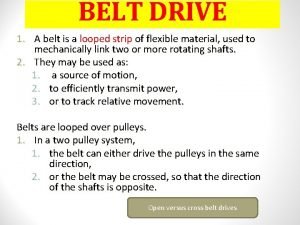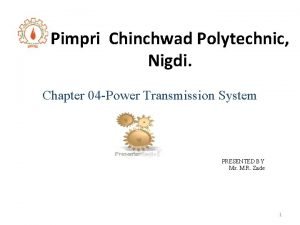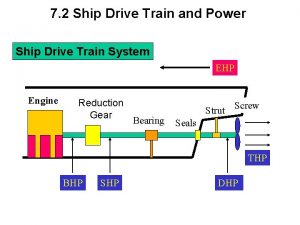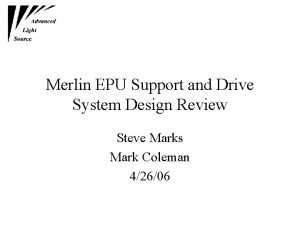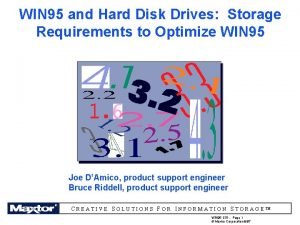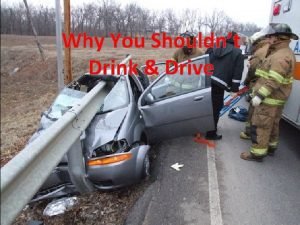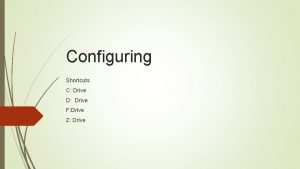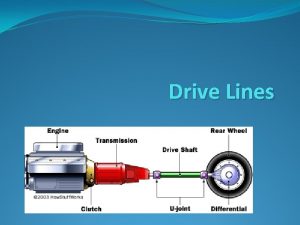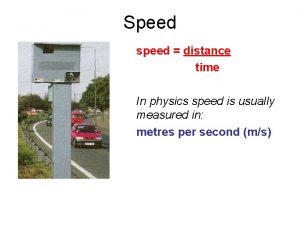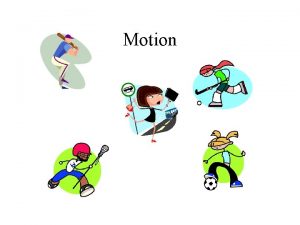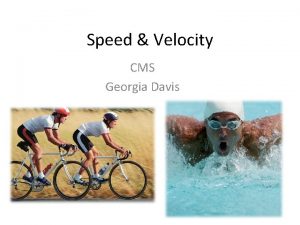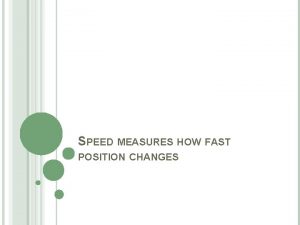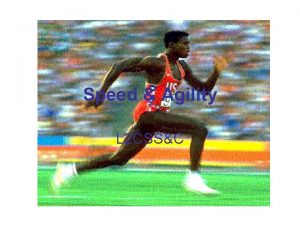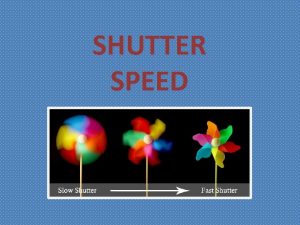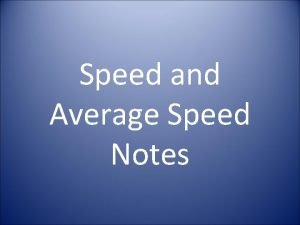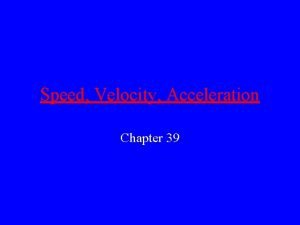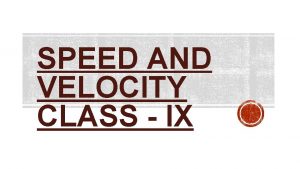G 2s Drive System Primer 2 Top Speed


















- Slides: 18

G 2’s Drive System Primer 2 – Top Speed and Wheel Configuration 2 November 2015

Recap of Primer 1 � Acceleration can be limited by: ◦ Traction or friction (wheel spin-out; limited on level ground by m of wheel tread and fraction of weight over driven wheels) ◦ Stability (robot falls over; limited on level ground by a=lg/h; mitigated by low center of gravity and long wheelbase. ) ◦ Thrust or drive force (breakers trip, motors release blue smoke; limited by current draw, mitigated by using low gear ratios, at a cost of top speed. ) is limited to the smallest of these three limits. � Acceleration

Top Speed � “Free Speed” of a robot is typically calculated using the free speed of a motor, divided by the gear ratio, and multiplied by the circumference of the wheel. � Actual top speed is usually 75% to 85% of the free speed; often a ratio in this range is used to report a “top speed” or “design speed. ” This ratio is known as “frame efficiency. ” � Using an 80% frame efficiency, the top speed of a CIM -driven FRC robot is 18. 5 ft/s * wheel-diameter in inches / (high) gear ratio. � FRC robots with a top speed below 10 ft/sec (fps) are considered slow for most games. A top speed of 20+ fps is unusually fast, and is usually only effective with a shifting gearbox.

Steering � Steering: The process, action, or system by which a vehicle/vessel/robot changes its direction of motion or facing (orientation). ◦ Automobiles typically perform this by rotating some or all of the wheels around a vertical axis. ◦ Tanks perform this by driving two different drive trains at different speed, and skidding through the turn. ◦ Traditional boats perform this through a rudder which applies a force against the fluid through which the vessel travels. ◦ Motorcycles and aircraft perform this by leaning, and letting gyroscopic or lift differential forces act.

FRC Robot Steering � Because of the desire to drive all of the wheels, and in the interest of reducing the number of moving parts, most FRC robots utilize wheels or treads with fixed axles. � Slightly more complex robots utilize wheels in which axles move (essentially) vertically, to change which wheels actually touch the floor. � High-end robots utilize steered wheels � Rarely, robots utilize legs, or have no traditional drive train at all.

Fixed Axle, Solid Wheels � Fixed axle robots with solid wheels or treads almost always consist of two essentially equal (mirror image) parallel drive systems, in which all of the wheels in each system move at the same speed. � Rotation is obtained by moving one drivetrain slower than the other, or even in reverse. � Because this causes wheels to slip on the floor, it is called “skid-steer”, or more informally, “tank drive”. Forward Reverse Slight Left Hard Left Pivot Left

Skid Steer “Steerability” � Consider the two skid-steer robots at right as they attempt to pivot. The upper robot has a long wheelbase and narrow tread, the lower has a short wheelbase and wide tread: � The drive directions are shown in red: � The wheels move as shown in green: � It is easy to see that the “long” chassis at top could not generate enough torque with the drive wheels to make the chassis turn, but that the “wide” one would have little difficulty.

So let’s make wide robots! � Not so fast! Don’t forget that a robot’s acceleration forward or in reverse is stability limited by a=lg/h. Really wide robots have a small value for l. � To enable a robot to both turn and be stable, most skidsteer robots with solid wheels have “drop center” axle(s), which gives the robot a fairly long length from the wheel to Co. G, while keeping the effective tread-to-wheelbase ratio “wide”. L Co. G L Accelerate to the left right

Skid-Steer Variants � Drive trains with eight or more wheels are usually only used to climb over obstacles. � Some or all of the corner wheels may be replaced with omni wheels; the drivebase is then usually flat (no drop center). This makes it easier for the robot to steer, but also makes it easier for another robot to push it into rotation. Sometimes only four omni wheels are used (no solid wheels), but these robots are easily pushed sideways. � Sometimes idle omnis or casters are used on two or four corners. This is simpler to implement, but also reduces traction limits as weight is placed on non-drive wheels.

Holonomic Drives: Definitions � Caveat: “Holonomic” has different meanings to different people. � In the original sense, it means that a device has the same number of controllable degrees of freedom as it has physical degrees of freedom. If you take physics or engineering in college, this definition may make sense to you someday, or ask me after class. � In another sense, it is used to categorize wheels or other drive mechanisms with transverse or angled rollers, whether omni, mecanum, or otherwise. � As most commonly used in FRC, it means a drive system that can be made to move sideways (as well as forward, reverse, and rotate), without actuating any wheel axes in rotation or vertically. Unless I say “holonomic wheel”, this is the definition I’m using in this presentation.

Holonomic Drives: Examples 1 � The archetypical holonomic drive (meets all three definitions) is the kiwi drive, which features 3 omni wheels at the corners of an equilateral triangle. � By suitable selection of speeds on the three wheels, this drive can move and rotate as needed at any time.

Holonomic Drives: Examples 2 Killough Mecanum � Killough and Mecanum drive have four wheels, so only meet definitions #2 and #3 to be holonomic. These two systems are kinematically equivalent (see how the arrows point the same directions), though mecanum is easier to build now that the wheels are available off-the-shelf from several vendors.

Holonomic Drives: Examples 3 Slide Drive: with 5 wheels, it’s hard to get loads balanced U drive: concept only. Will tend to torque on slide; gyro or encoders are essential. H-drive (slide) Meckiwi: First seen Oct 2015. It should drive better along the tread of the omni wheel than along its axis. U drive Meckiwi

Actuated Drives � Actuated drives have “alternate” drive systems that can be engaged by “pushing” and “lifting” the wheels associated with these alternate systems. Drive actuation is almost always through pneumatic means because of the forces needed and the requirement to “hold” at both ends of travel. � The actuated wheels will differ from the “normal” drive in gearing, construction, or orientation (possibly all three!)

Actuated Drive Examples 1 � Actuated Slide/H is an option of the Slide drive in which the “strafe wheel” may be lifted. � Lobster usually has non-holonomic wheels all around, but the “alternate” wheels are oriented perpendicularly to the “drive” wheel

Actuated Drive Examples 2 � � Octanum/Butterfly has four mecanum wheels and four solid wheels. The solid wheels are typically geared lower. All four wheel pairs are usually actuated at the same time. Grasshopper is just like octanum, with omni wheels. Nonadrive is grasshopper with a strafe wheel. Strafe may be actuated with the other omnis, or separately. In each of these cases, the solid wheels can be moved to the corners for greater pushing power at the cost of steerability. Octanum Grasshopper Nonadrive

Steering Drive examples � Swerve modules allow a wheel to be both driven and steered. � Some have the motor steered with the wheel (above), which limits the turning angle unless you use slip rings. � Axial swerve modules have the motor on the chassis side. They are more complex, but allow infinite steering.

Steering Styles � Crab drives steer all of the wheels together, and sometimes drive all of the wheels from the same gearbox. This allows the robot to travel in any direction, but not rotate. � Swerve drives allow independent wheel steering and power. This allows the robot to rotate as well as translate in any direction. � Due to the weight and cost of swerve modules, crab and swerve robots are most likely to have three wheels. � Linkage drives steer wheels in pairs, or turn one set of wheels in the opposite direction of another.
 Https drive google com drive u 1 shared with me
Https drive google com drive u 1 shared with me Googlehttps://drive.google.com/drive/my-drive
Googlehttps://drive.google.com/drive/my-drive Google drive
Google drive Differentiate between belt drive and chain drive
Differentiate between belt drive and chain drive Https drive google com file d 0b8f5bmoit8kbmx
Https drive google com file d 0b8f5bmoit8kbmx Http drive google com
Http drive google com Difference between belt drive and chain drive
Difference between belt drive and chain drive Mpgu
Mpgu Speed time distance formula
Speed time distance formula A narrow field of vision (140 degrees or less) is called...
A narrow field of vision (140 degrees or less) is called... Speed detection of moving vehicle using speed cameras
Speed detection of moving vehicle using speed cameras Ship drive train
Ship drive train Google drive system design
Google drive system design Top of the caste system
Top of the caste system Is earth an open or closed system
Is earth an open or closed system Digestive respiratory and circulatory system
Digestive respiratory and circulatory system Windows 95 max hard drive size
Windows 95 max hard drive size Why you shouldnt drink and drive
Why you shouldnt drink and drive Drive reduction theory ap psychology
Drive reduction theory ap psychology



